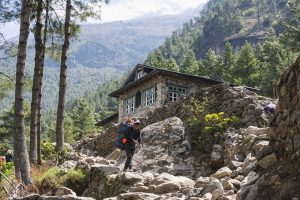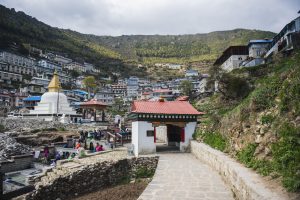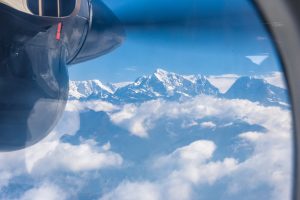Rough Conditions
After Phortse the conditions of each village continued to worsen. Dingboche, Lobuche, and Gorak Shep were all impoverished communities filled with makeshift buildings and isolated from anything other than tourists seeking to reach Everest. The prices of even the simplest commodities increased significantly as village’s became more remote and higher in altitude. In Gorak Shep, the last village before Everest Base Camp, there is no fresh water other than bottled water, which costs $4.00 per bottle. Buildings were fashioned out of nothing more than thin sheets of plywood and sheet metal for roofs. Electricity relied entirely on solar energy, meaning cloudy days resulted in blackouts. There was no plumbing or running water, so waste was collected over time and had to be carried down the trail every so often for disposal. During the night, even at the end of May, temperatures were as low as 10ºF and winds blew incessantly. It was an experience of contrasts, as the conditions were absolutely dreadful, but the mountain scenery was simply stunning.

The foggy and windy trek from Phortse to Dingboche.

The small and isolated village of Dingboche. From this point on I had no outside contact due to lack of cell or satellite reception.

Arriving in Dingboche. It was not as deserted at Phortse, but still an eerily small and foggy town.

An overhead view of Dingboche with Ama Dablam in the background. You can tell that it is surrounded by mountains on all sides, making it quite disconnected from the rest of Nepal.

An unnamed peak shot from my teahouse window in Dingboche during the afternoon fog.

The village of Lobuche. This is one of the two villages that are abandoned during the off-season for trekking. Only one or two locals stay to maintain the property year-round.

The small settlement of Gorak Shep (to the left) was actually there original Everest Base Camp until it was shifted closer to the Khumbu Ice Fall (the small white patch of ice to the right). It is now the highest elevated settlement in the world.
Reality versus the Imagination
These conditions were temporary for me, but for the local Nepali people… this was their life. Crumbling buildings, trash everywhere, no running water, cold conditions, lack of resources, and the constant smell of feces. It may be easy to romanticize the idea of living in the remote mountains, surrounded by beauty and farming in an environmentally sustainable manor, but the reality of it is dark, difficult survival. Most of the people who live in these regions, wish to leave.

An up close view of Gorak Shep, which is composed of about 5 or so buildings made of plywood and sheet metal.

An example of the rooms at higher altitude. Most had very thin plywood walls and one lightbulb (which only sometimes worked).
Arriving at Base Camp
Of course, our final destination made the difficult journey worth every bit of trouble. After 9 days, over 100 miles, and 8,000 feet of elevation gain, we arrived at Everest Base Camp. Walking alongside the Khumbu Glacier as it cracked with a thunderous roar, surrounded by nothing but Mars-like fields of rock, and looking in every direction to see towering snow covered peaks—this was a surreal experience. We walked up the icy trail to a large monument dressed in Buddhist prayer flags with a small sign that read “Everest Base Camp – 5,364 meters.”

A memorial built to Rob Hall, the head guide of expedition that became known as the 1996 Mount Everest Disaster. A blizzard hit the summit, costing Hall’s life along with the lives of seven others.

Walking on top of one of the lower sections of the Khumbu Glacier on the trek to Lobuche.

The sign pointing out which way to Everest Base Camp. Without it the trail would be impossible to navigate.

Walking alongside the Khumbu Glacier, the highest glacier in the world.

The otherworldly landscape of the Khumbu Glacier as it stretches 15 kilometers alongside Nuptse and to Everest’s base.

Me posing in front of the Khumbu Glacier – only mere miles from the foot of Mount Everest.

A closer view of the Khumbu Glacier, which roared with loud cracks from ice shifts as we walked alongside its massive frame.
The camp was beautiful. Sitting atop the Khumbu Glacier, dusted in snow, and covered in bright yellow tents, it had an energy unlike any other place I have ever been. This was the epitome of exploration. Home base for the world’s bravest and most motivated climbers. We could stare straight ahead to see the Khumbu Icefall—the deadly, crevasse-filled gateway to Everest—only a football field away. From there it was easy to see the route, as it stretched between Nuptse and Everest’s Eastern ridgeline, up to the South Col (the lowest point between Everest and Lhotse). It was as though I could simply start walking in that direction and find myself on top of the world in no time at all. The reality, however, is much more difficult.

Our first clear view of Everest Base Camp. While the peak of Everest is not visible from this point, you can see where the Khumbu Icefall leads to the top (far to the left).

The bright yellow tents of Everest climbers serve as the quintessential landmark of EBC.

Because Everest Base Camp is situated on top of the Khumbu Glacier, all structures must be moved every five days or so to account for changes in the shape of the glacier itself.

My final arrival at Base Camp! It was a long and hard 14 days!

The whole crew pictured by the flag adorned monument for Everest Base Camp. American, Australian, English, and Nepali climbers all together!

Celebrating our accomplishment of making it to EBC together.
Our team congratulated each other, hugging and shaking hands, then took a number of photographs to commemorate our achievement. Standing in front of Everest revealed just why this mountain so deeply captures the world’s imagination. It is the embodiment of man versus nature. It is the quintessential example of humankind’s thirst for adventure. And it is the ultimate shrine to human curiosity. There is something about the unknown, the dangerous, and the mysterious parts of this earth that attract the human spirit. Perhaps it is admiration. Perhaps it is madness. Nonetheless, people will always climb mountains and Everest will always be a landmark achievement for any person that attempts it.

Kala Patthar (or Kala Pather) is the only location from which the peak of Everest is visible for trekkers. It is a small mountain (really more of a large, steep hill) that reaches 18,500 feet of elevation. It’s name means “Black Rock.”

Pumori in the morning glow while our team hikes toward Kala Patthar to catch a sunrise view of Everest’s peak. Its name means “Little Daughter” and was names by George Mallory—the first climber to attempt Everest in 1924.

The golden sunlit face of Pumori’s south summit.

Me after successfully summiting Kala Patthar. Standing tall at 18,500 feet!

Beginning the journey back home after completing Base Camp.
Everest’s Relationship with Nepal
For the last half century, Everest has been the driver of change in Nepal. There is a reason it is pictured on all currency and every Nepali brand seems to have ‘Everest’ somewhere in the name. Everest is Nepal’s currency. It is Nepal’s brand. People respect it, fear it, and celebrate it.

A sunrise view of Everest (the tall black peak to the right). This is the best view of its peak within trekking distance, as Everest is surrounded by other mountains including Nuptse (right) and Khumbutse (left).
Thanks to the international exploration of Everest, Nepal established a friendly relationship with the Western world long ago, ensuring it would never be conquered. Instead, it has profited from a mutually beneficial unwritten contract—the West can explore as long as Nepal can make money off of it. This has led its cultural, economic, and social diffusion. Nepal has taken what it likes from the West and left what it dislikes, making significant gains in overall development… thanks to the allure of the mountains. Now it is up to Nepal to take the next step in its growth.

Many successful (or unsuccessful) mountaineers fly back to Lukla via helicopter because making the 5 day trek back down after summiting Everest is the last thing on their mind. Helicopters are also used for emergency evacuations due to injury or altitude sickness.
Much to Be Done
One of the largest problems for mountain communities in Nepal is isolation. Mountain residents lack connection to the rest of the country and the world. Apart from satellite WiFi, they are separated from all other civilization by days of trekking across harsh and unforgiving terrain. However, locals and foreigners alike are against the building of roads throughout the region. They believe it would destroy the nostalgia of its primitive by-foot-or-yak-only transportation system and the adventurous feel of being in a remote place. While this is absolutely true, turning away from infrastructure growth and investment in these villages will result in the continual stunting of Nepal’s growth and a perpetual reliance on one industry—tourism.
Roads must be built to connect the people of Nepal. Towers must be built to transmit reliable communication. Schools must be built to educate students for a more skilled workforce. Hospitals must be built to make for a healthy and strong people. Businesses must be built in order to pull the region out of poverty and into the developed world.

The massive valley of Pheriche is a major transport route and a perfect candidate location for building a road. It stretches from Lobuche nearly all the way to Phortse.
There is a way for Nepal to grow, while simultaneously preserving its culture and environment. That is the purpose and ultimate goal of my next assignment—working in environmental conservation in the remote mountainous region of Annapurna. There I will explore the possibilities of a middle ground between economic growth and environmental sustainability.

Boarding the flight back to Kathmandu from Lukla—the official end of our alpine trek. We actually trekked to a higher altitude than this plane flew.






























































































































